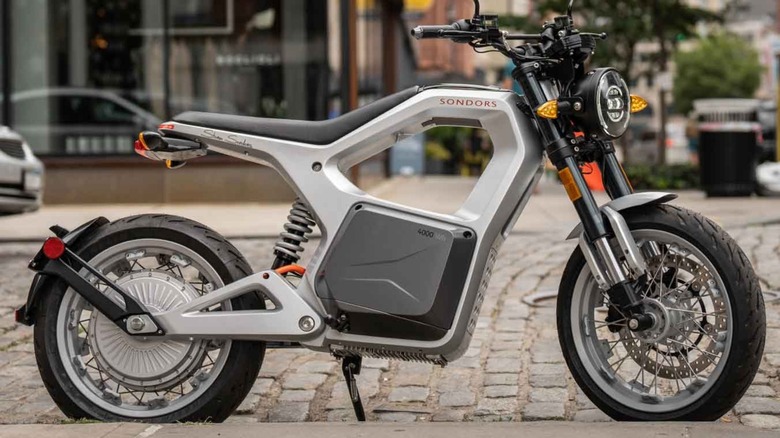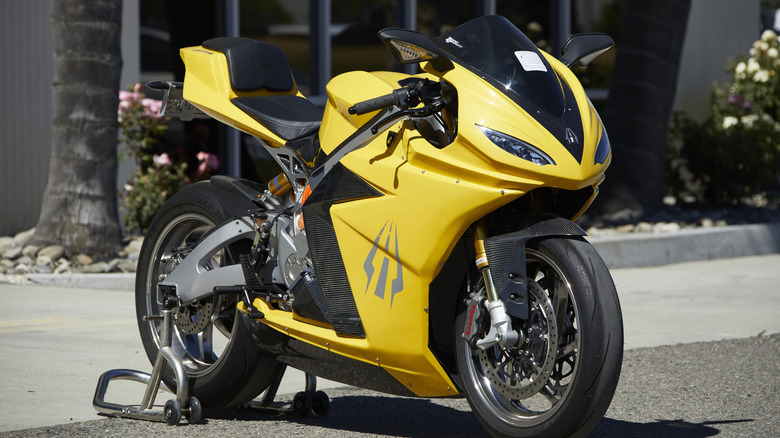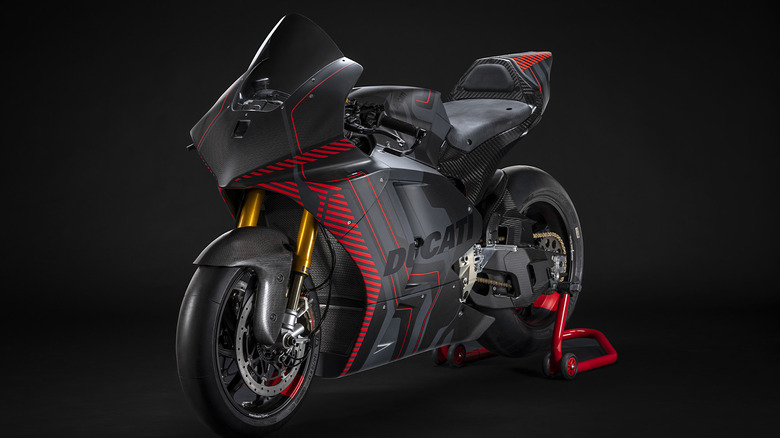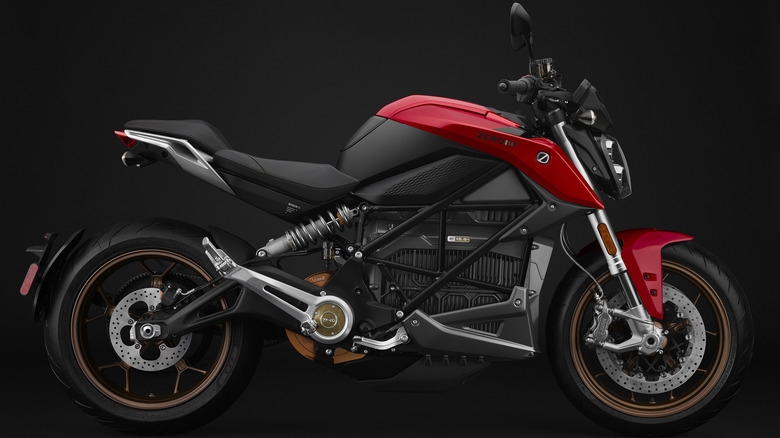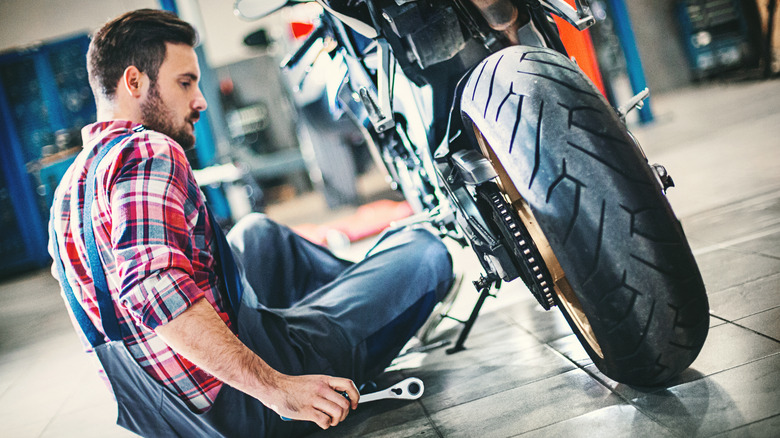4 Disadvantages Of Electric Motorcycles That Will Keep You Riding A Gas Powered Bike
There's no doubt that all-electric automobiles are gaining a foothold in the marketplace. In the United States, EV sales in the most recent quarter (ending June 2023) are up 48% versus the same time period last year. Motorcycle riders, on the other hand, have been more hesitant to switch over from their internal combustion powered machines to battery-electric counterparts.
In America, there exists approximately nine million motorcycles, which represent just 3% of all registered vehicles, so it's understandable that technological progress has been slower than the warp speed at which electric cars are progressing. To date, not a single one of the "big four" Japanese motorcycle manufacturers are marketing an all-electric bike in the U.S.
While everyone is in favor of a healthier planet and saving money on fuel costs, for many riders, the product advancement of electric motorcycles just hasn't reached the required level of adoptability, for several different reasons. Here's why you might want to stick with good old fossil fuels for bikes, at least for a little while longer.
Reduced range
A topic that's frequently in the spotlight regarding any electric vehicle is range. That's particularly pertinent with motorcycles, since their smaller packaging doesn't allow for batteries as vast as those in four-wheeled vehicles. Typically, vehicles are more efficient at consistent highway speeds than in stop and go city traffic.
As we learned in high school physics class, it takes less energy to keep an object in motion than it does to put an object in motion. However, electric motorcycles defy that logic by struggling with reduced aerodynamics at highway speeds and the lack of regenerative braking to help refill the battery.
While there are several electric motorcycle manufacturers boasting a range greater than 200 miles in city driving conditions, most OEMs struggle to achieve even half that distance when traveling at highway speeds. Once the battery is depleted, the charging time to replenish is often measured in hours rather than minutes.
At least one company, Lightning Motorcycles from California, boasts silicon-anode batteries on certain models that the company claims can fully charge in as little as 10 minutes. While that's certainly promising, it's not indicative of the mainstream — yet.
E-motorcycles can fulfill the requirements of students, urban commuters, or just running errands around town, but long distance touring is still the uncontested domain of the gasoline-powered bike.
E-motorcycles are heavy
Another potential downside to a zero-emissions future is that electric bikes are heavier than their gasoline siblings. For expert riders, this extra weight from a battery pack might represent a small sacrifice in throwing the bike nimbly through curves, but new and smaller riders may have a more difficult time maneuvering battery-ballasted bikes in close quarters, like when parking.
"Let's not kid ourselves, whilst the performance of an electric bike is incredibly impressive in terms of straight-line acceleration, quite clearly they are always going to be a heavier vehicle," said Steve Sargent, Triumph's chief product officer, in comments to Crash.net. In a similar statement, CEO of Ducati Claudio Domenicali agreed that "For electric motorcycles, the main problem is the [battery] weight."
Ducati's solution is to make the other components of the bike as light as possible — such as the extensive use of carbon fiber — to compensate for the portly battery, but it's important to note that both executives quoted above were speaking as it pertains to racing. For street riding, the disparity in weight might simply present a learning curve. Still, riders seeking absolute razor's edge handling will probably favor classic gasoline propulsion.
Higher up front cost
Like electric cars, e-motorcycles use fewer parts than ICE motorcycles, yet their purchase price is considerably steeper on average. Products from Zero Motorcycles (above) — sometimes referred to as the Tesla of motorcycles — start at $11,195 for street models, and range up to more than $20,000.
The $11,195 Zero S has a range of about 70 miles in combined city/highway driving, and takes five hours to charge via a regular 120-volt household wall outlet. By comparison, Honda offers a selection of well regarded 500cc displacement gasoline bikes like the CB500F and CB500X that hover around the $7,000 mark, and are capable of traveling more than 200 miles between fill-ups.
Electric motorcycle executives do expect production costs to fall as the business scales and technology becomes more affordable. For that to happen, a major manufacturer like Honda or Kawasaki would need to get involved. For its part, Honda announced plans last year to introduce 10 new e-motorcycles by the year 2025, and expects the segment to comprise 15% of total motorcycles sales by the year 2030.
Motorcycle giant Kawasaki is moving a little more quickly, with two new e-motorcycles nearing readiness for sale right now, according to the brand earlier this month. Small in stature and geared toward city use — with an approximately 15 horsepower motor and a removable battery for off-site charging — the two bikes are expected to cost in the $5,000-$6,000 range in order be price competitive.
The satisfaction of turning your own wrenches
In the cult book "Zen and the Art of Motorcycle Maintenance," one of the riders owns a pricey new bike on which he's reliant on professional mechanics to repair and tune. The other rider has an inexpensive older machine that he keeps running in tip-top shape by himself.
More so than car owners, many motorcycle riders fall in the latter category and enjoy the tactile experience of tinkering and improving their bikes. Some schools of thought maintain that e-motorcycles are going to take away the pleasure of traditional wrenching, but that's not entirely true.
With electric, of course there's no motor oil and filter to change, nor a clutch disc (they're sans transmission), spark plugs, or coolant. Still, those that like to putter around the garage on weekends and/or economize on upkeep will find the usual final drive chain or belt that needs adjustment or occasional replacement, conventional brakes and suspension to tweak, and, of course, tires to replace.
Also, as the e-motorcycle market grows, additional aftermarket accessories will meet the demand for personalization. For some, that still might be little consolation for the lost pleasure of tuning up a rumbling V-twin.
